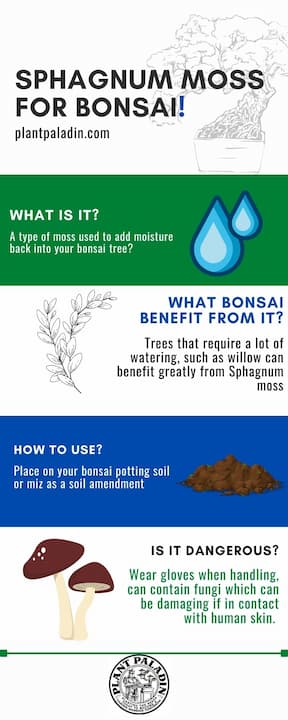This website is supported by its readers. If you click one of my links I may earn a commission. I am also a participant in the Amazon affiliates program and I will also earn a commission from qualified purchases.
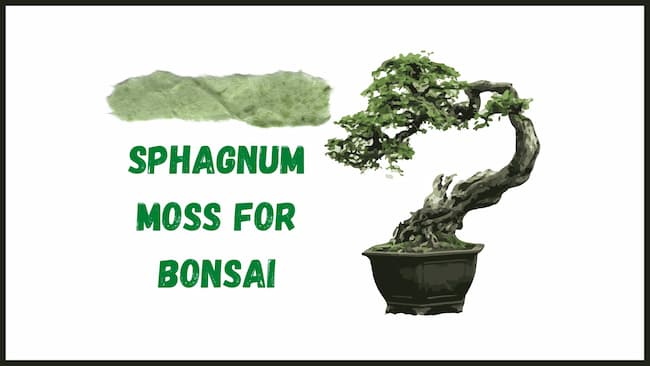
So a few weeks back, I went on a two-week vacation to Turkey. Now, this was the longest I was leaving my bonsai trees alone, so naturally, I was worried about how much moisture my trees would get in the scorching summer. Thankfully I came across sphagnum moss for bonsai.
Natural sphagnum moss is a fantastic moss that you can use on bonsai trees and other plants to add moisture, improve airflow and add decoration to your bonsai tree. The moss contains a perfect blend of oxygen and moisture, ensuring your bonsai won’t dry out.
So what are the different uses for sphagnum moss? And are there any dangers to using it? And exactly how much does sphagnum moss cost? Keep reading to find out more!
Just a quick heads up, over the past three years of running Plantpaladin, hundreds of people have asked for product recommendations. As such, You can find my favorite indoor bonsai tree here (link takes you to Bonsaiboy), my favorite outdoor bonsai tree (link takes you to Bonsaiboy), or have a look at all the products I recommend here.
What is sphagnum moss?
Sphagnum moss is a long-stranded moss used by hobbyists and gardeners.
It is typically used for adding moisture back into trees, helping air layer certain trees, or for aesthetic purposes such as creating a bit of color to a tree’s appearance.
For bonsai trees, sphagnum moss is most commonly placed either in the soil to help bonsai species with weak root structures or on the topsoil and trunk to add more vibrance to the tree.
Sphagnum moss is typically a tiny moss that clump together (like most mosses) and comes in various colors, from red to green.
While sphagnum moss has been used for many centuries in line with bonsai trees and other horticultural activities, some species can contain fungi that can prove harmful, so caution and care should be undertaken if used.
Sphagnum moss peat can also be used as bonsai potting soil.
Peat moss is just the broken-down composted version of sphagnum moss.
Sphagnum moss for bonsai
Sphagnum moss has been used for hundreds of years in bonsai; however, like me, you probably have several questions about using it.
Before I went on holiday, I got in touch with a few bonsai experts, visited my local botanical gardens, and surveyed 20 plant paladin readers, asking them how they used sphagnum moss.
To summarize:
- Sphagnum moss is mainly used to add moisture to a tree.
- This works particularly well when you cannot water your bonsai trees for a significant period, or you are transporting your bonsai tree.
- Other common uses of sphagnum moss are purely aesthetic, adding bright-colored moss to your bonsai’s branches, trunk, and topsoil to make it more visually pleasing.
- Sphagnum moss typically costs $11 per 100grams of dry sphagnum moss and 85 cents per 100g of wet sphagnum moss.
- Usage of sphagnum moss works best on trees that require a lot of moisture – willow trees and other hardwood outdoor trees, such as oak, will benefit the most from using sphagnum moss.
How much does sphagnum moss cost?
Sphagnum moss costs $18.52 per pack. Dry sphagnum moss costs $11 per 100 grams. Live wet sphagnum moss costs significantly less at 85 cents per 100g.
To help find out exactly how much sphagnum moss costs, I researched ten different sphagnum moss brands, got an idea of how much they cost, and compared different sizes.
I wanted to see if there is a difference in price between live wet sphagnum moss and dry sphagnum moss.
You can see the results in the table below:
Brand | Cost | Type | Cost by weight |
Supermoss | $23.99 | Dry (1 pound) | $5.29 per 100g |
Grow Tropicals | $30.48 | Wet/live (16 litre) | $1.90 per 100g |
Gardman | $33.86 | Wet/live (3.7 kilos) | 90 cents per 100g |
Multitwins | $16.99 | Dry (200g) | $8.49 per 100g |
Toypopor | $11.99 | Dry (2.89 ounces) | $14.63 per 100g |
Swell | $4.05 | Wet/live (1 litre) | 40 cents per 100g |
Soil ninja | $15.81 | Wet/live (10 litre) | 15 cents per 100g |
Habistat | $8.78 | Wet/live (1kg) | 87 cents per 100g |
Spagmoss | $29.99 | Dry (150 grams) | $19.99 per 100g |
Happy snails | $9.95 | Dry (150 grams) | $6.63 per 100g |
How to apply sphagnum moss to bonsai
Most of you will be doing so to quickly figure out how to apply sphagnum moss to your bonsai tree.
To do so:
- Collect your sphagnum moss
- Remove any ariel roots and clean your topsoil.
- Apply an even layer of dry sphagnum moss to your topsoil
- Apply additional live sphagnum moss
- Water the moss
Let’s explore these in more detail:
Collect your sphagnum moss
First up, you need to collect your sphagnum moss.
Unlike other mosses, collecting sphagnum moss can be difficult.
Most sphagnum mosses typically grow in bogs or swamps. Taking large amounts can harm the surrounding area if taken fresh from their natural habitat.
Instead, there are two options you can follow:
- Purchase from a reputable online retailer or garden store
- Grow your sphagnum moss
I’ll talk about my recommendations for sphagnum moss later in this post
To grow your sphagnum moss, fill a wide short tray or pot with water until it is about an inch or two high. Place live sphagnum on the after and spray with foliar fertilizer every three weeks.
You can then dry out the sphagnum moss or use live sphagnum.
Clean up your topsoil
Once your sphagnum moss has been prepared/purchased, you must prepare your bonsai tree.
To do so, use a sharp pair of scissors or sheards and remove suckers, aerial roots, or branches growing directly from the topsoil of your pot.
You can use this opportunity to trim or prune your bonsai tree.
Once the topsoil has had any debris cleaned, use a bonsai brush to level out the topsoil gently so it is easy to distribute your moss.
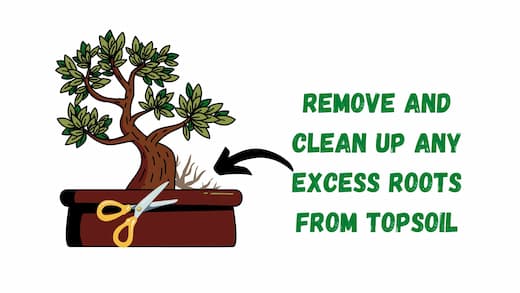
Apply the dry sphagnum moss
Next up, you will want to apply dry sphagnum moss on the topsoil.
So why dry sphagnum moss and not live sphagnum moss?
Well, if you were to put regular live moss on top of the potting soil, it would only stay moist for as long as the soil was moist.
As such, dry sphagnum moss acts like a wet blanket keeping the live sphagnum moss, you will place on top of the soil moist.
To apply, gently place and compress your sphagnum moss on the topsoil until you have formed a thin layer.
Then water to add moisture to the moss.
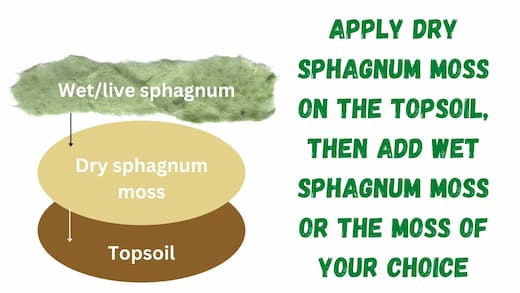
Apply live sphagnum moss
So now you have a bed of dry sphagnum moss on your potting soil; we can add your live sphagnum moss.
This will add a lot of extra moisture to your tree and give your bonsai that natural, wild look.
To add your moss, start by placing the cultivated or wild sphagnum moss against the trunk of your tree.
Then make your way clockwise or anti-clockwise around your tree.
Avoid adding multiple layers of the live sphagnum moss on top of each other, as this can cause drainage problems, leading to dead bonsai roots.
Other applications of sphagnum moss in bonsai?
So while the above mythos is the most common method used for sphagnum moss (this adds both moisture and aesthetics), are there any alternatives?
If you want your potting soil to have more moisture but do not want sphagnum moss to grow on your tree, you can mix your soil with parts of live sphagnum moss.
This will work almost as grit, in the same way an inorganic material such as akadama or volcanic ash rock work.
Typically 20% live sphagnum moss mixed with the potting soil of your choice will work best.
What is sphagnum moss for bonsai used for?
Sphagnum moss has several primary uses when it comes to creating bonsai. These include:
- Water retention and moisture
- Nutrient absorption
- Improve aeration
- Protection against excessive heat and light
- Aesthetic reasons
- When transporting bonsai
- As a soil amendment
- To help weaker trees
Water retention and moisture
The biggest reason sphagnum moss is used is its water and moisture qualities.
Sphagnum moss can absorb up to 8 times its weight in water.
You don’t need me to tell you the benefits of why bonsai needs water, but I found that this is especially useful if you have a smaller-sized bonsai that regularly dries out or if you underwater your bonsai.
Putting a bit of the moss in the soil mix will help absorb the water and keep your soil moist.
Ensure that you regularly check the water levels; if you leave the moss too wet, you can potentially cause root rot.
Nutrient absorption
While many of us like to use inorganic material in our soil mixes, such as pebbles, stones, or even rubber chunks, as a way of helping with water flow, sphagnum moss is also commonly used in soil mixes.
Not only for its water absorption abilities laid out above but also for its ability to pass on nutrients.
While pebbles and stones are great, they do not have any nutrients they can pass on to your tree.
However, this is not the case with sphagnum moss, which, if you use fertilizer, absorbs the nutrients and better helps your bonsai absorb them over time.
This can ensure your fertilizer lasts longer and your bonsai tree stays healthier for longer.
Improve aeration
Now while moisture is often the critical aspect of use for sphagnum moss, you can go the opposite direction with the moss and use it to help improve the aeration of your plant.
Oxygen is essential to bonsai’s roots to help them grow and absorb nutrients.
Too often, bonsai owners use the wrong soil mix and cut off the vital oxygen our plants need.
Using sphagnum moss and a smaller amount instead of cramming it in your pot when wet will help your soil breathe and improve aeration, leading to a healthier tree.
Make sure your bonsai pot has a lot of drainage holes to further help with the aeration process if using the moss.
Protection against excessive heat and light
So what about using sphagnum moss in the topsoil?
Enter heat and light
This is incredibly important if you live in a warmer climate or are experiencing a super hot summer.
Bonsai love water and light but can even suffer from dry, dusty soil and dehydration in a hot climate.
Grinding sphagnum moss, putting it on the topsoil, and watering it will ensure your soil and plant can stay hydrated and avoid the soil turning too dusty or drying out.
In turn, you are protecting your plant from excessive heat or light.
Aesthetic reasons
Most expert bonsai owners will use different mosses to make their tree’s aesthetics more pleasing.
This is especially apparent at bonsai events, where bonsai owners cover their topsoil in different mosses instead of having exposed soil for a more visually pleasing look.
Some of these mosses dry out quickly, so sphagnum moss, which is notorious for holding onto moisture and water, is often used.
On top of this, sphagnum moss comes in various colors ranging from green to dark purple/red, meaning it can make bonsai stand out.
Transporting bonsai
If you are transporting bonsai long distances or know that you may not be able to water your bonsai for a few days, then you can use sphagnum moss to help.
It’s one of the reasons you can find it in the transport and logistics of bonsai.
You will usually water the sphagnum moss until it expands eight times and use it in the soil mix or as topsoil to keep the bonsai watered during long journeys.
Soil amendment
I love using cactus soil for my bonsai because of the different organic and inorganic materials you find.
Pebbles and granite chips are all found alongside perlite and traditional peat soil.
One of the most common ways sphagnum moss is used then is in place of perlite or other materials in a bonsai soil mix.
This process is better known as a soil amendment – this is just a fancy way of saying materials are added to your soil to improve its composition – mainly for things like aeration and moisture, giving a better environment for your bonsai roots to thrive.
Improve weakened bonsai
If your bonsai has been weakened because of excessive pruning, a bad environment, or poor soil, then sphagnum moss has traditionally been used to revive weak bonsai.
Sphagnum moss has antiseptic properties, which can help heal or remove any toxins affecting the roots of your bonsai.
It is also great at passing nutrients and water to the roots of your tree – especially if added as a soil amendment.
This means that if used in a tree weakened by an insect infestation, it will give it a fighting chance to survive.
Study on what people use sphagnum moss for bonsai for
So while I covered the main reasons why people use sphagnum moss above, I wanted to understand more and see what the average bonsai hobbyist like you and me used sphagnum moss for.
How did I undertake the study?
With plant paladin regularly getting over 10,000 readers per month now, we have access to quite a few people who regularly answer our polls.
As such, I got responses from 20 readers who own bonsai trees and regularly use sphagnum moss.
I then asked them which of the following they use sphagnum moss for:
- Increasing moisture
- Transportation
- Aesthetic purposes
- Improving nutrient absorption
- Better soil aeration
Survey results
As you can see from the survey results, the primary reason people use sphagnum moss is the moisture levels that this moss can provide.
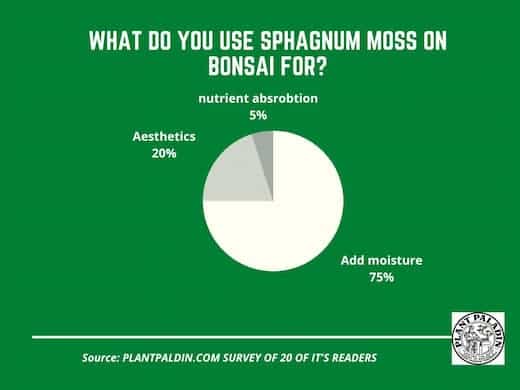
While aesthetic reasons were second, I was surprised by how free people opted for the aesthetics and chose the practical purposes for the moss over any visual elements sphagnum moss can offer.
Disadvantages of using sphagnum moss for bonsai
We have discussed some of the advantages of using sphagnum moss for bonsai. However, there are a large number of disadvantages that you should be aware of.
Root rot, unsustainability, salt retention, and potential health issues, such as Sporotrichosis, are the significant disadvantages of using sphagnum moss in bonsai. Consider avoiding it if you are a beginner to bonsai. More advanced bonsai owners can excel in using the moss effectively and safely.
Let’s explore these in more detail below.
Potential health problems
I am not a doctor, so please do not consider this medical advice.
That being said, the major health issues with sphagnum moss come from Sporotrichosis.
Sporotrichosis is a fungal infection common amongst farmers, gardeners, and other horticulturalists.
It usually happens when the skin makes contact with the infected fungus.
As sphagnum moss originates from bogs and can be found on the top layer of peat moss, it is more common and likely that sphagnum moss contains Sporotrichosis.
In a 1981 study, the BCHP found a case whereby two brothers in Wisconsin who worked at a garden center contracted the disease, although it seems less likely to be all that common.
Not sustainable
Another major issue in using sphagnum moss is that it is not renewable.
This is because it is harvested from bogs that require the moss to maintain and manage its ecosystem.
Removing the sphagnum moss for bonsai use can destroy natural bogs.
With many of us trying to be as careful as we can in growing our bonsai, this can aid the argument that bonsai is cruel.
Root rot
A significant problem in using sphagnum moss for bonsai is that it can cause root rot.
As sphagnum holds onto water more than traditional soil, it can be straightforward to overwater your bonsai tree, which can lead to fungal or mold infections.
Root rot can occur, especially if using sphagnum moss as a soil amendment. So it would help if you handled it with care.
Can hold onto salt
Sphagnum moss is organic, so it can hold onto fantastic nutrients for feeding bonsai.
The downside to this, however, is that it will hold onto too much salt.
Too much salt can cause toxicity in plants and so to get rid of this, ensure you constantly water your bonsai from top to bottom if using sphagnum moss.
To counteract this, consider using rainwater or filtered water to prevent a further build-up of chemicals in your bonsai.
High PH
While most sphagnum moss will fall into the neutral category with PH levels at 7, as it comes from peat moss, some strands can be more acidic.
Some have a PH scale of around 4, which is significantly acidic, so you must ensure the sphagnum moss you opt for also works well.
Should you use sphagnum moss for bonsai?
Deciding to use sphagnum moss is a personal choice you need to make for yourself, but, in my opinion, I would use it.
Sphagnum moss is a fantastic moss used for bonsai to help with moisture, aeration, and aesthetics. While there are some negative downsides to using the moss, ensure you handle it with care, keep your skin covered, and check your bonsai regularly for best results.
How much water does sphagnum moss need for bonsai?
Sphagnum moss needs eight times its weight in water. This will provide enough water for the moss to be effective without damaging your bonsai. Some Sphagnum mosses can absorb much larger water ranges, usually falling between 10 to 20 times.
How to use sphagnum moss for bonsai?
Because sphagnum moss has so many uses, how you use it will vary.
To help, I’ve put together a table below, which shows the best way to use it for the problem you are trying to overcome:
Problem | How to use sphagnum moss |
Water retention and moisture | Water the sphagnum moss up to 8 times its weight and then plant it in the soil mix. If already using moss, plant this on top to keep the other moss moist. |
Nutrient absorption | Water the sphagnum moss up to 8 times its weight and then plant it in the soil mix. Use your fertilizer of choice and the sphagnum moss will help filter these nutrients into your bonsai |
Improve aeration | Water the sphagnum moss up to 4 times its weight and then plant it in the soil mix. Ensure your roots have enough room to avoid overwatering them |
Excessive heat and light | Water the sphagnum moss up to 8 times its weight and then plant it in the soil mix. Plant on the topsoil if the topsoil is excessively dry. |
Transporting bonsai | Water the sphagnum moss up to 8 times its weight and then plant it in the soil mix. You can also place it on the topsoil but only choose one of these methods to avoid overwatering. |
Improve weakened bonsai | Water the sphagnum moss up to 8 times its weight and then plant it in the soil mix. This will help the roots benefit from the antiseptic qualities of the moss. |
Soil ninja | $15.81 |
Habistat | $8.78 |
Spagmoss | $29.99 |
Happy snails | $9.95 |
Other mosses for bonsai?
So aside from Sphagnum moss, are there other mosses you should consider using for your bonsai? Either for aesthetic or bonsai health reasons?
I found the following mosses can also be used effectively for bonsai:
- Bryum argenteum
- Other Bryum species
- Ceratodon purpureus
- Atrichum
- Polytrichum
- Thuidium
- Ctenidium
- Hypnum
Just be aware that each of them has its advantages and disadvantages.
Where should I get sphagnum moss for bonsai?
Now, if you are interested in buying Sphagnum moss, there are over 350 species so it can be a little bit daunting.
The good news is that thanks to the comparison I undertook on the price of sphagnum moss earlier on, I found my three favorite suggestions.
Best dry sphagnum moss for bonsai
First, if you are interested in dry sphagnum moss, this is usually a bit pricer than wet sphagnum moss.
Luckily this does not have to break the bank. I found the best on the market to be Super Mosses Sphagnum Moss – The link takes you to Amazon.
Not only does it come in various sizes, but it can also hold up to ten times its weight which is more than most sphagnum mosses.
While you can get other mosses with a better price point per 100g, the added moisture this can hold makes it the best option.
Best wet sphagnum moss for bonsai
If you are interested in the best-wet sphagnum moss or live sphagnum moss for your bonsai, I would consider investing in gardens sphagnum moss.
It does not break the bank.
Buying sphagnum moss off the internet can be tricky due to transporting, but surprisingly, when I ordered this, it arrived fresh and ready to go.
You can grab it here (the link takes you to Amazon)
How to water your sphagnum moss for bonsai?
So you might think you can water it less if you add sphagnum moss to your bonsai.
After all, mosses add moisture back to our bonsai.
The truth is that watering your bonsai tree with sphagnum moss on is no different than watering bonsai without any moss.
Instead, water as you would normally.
Touch the topsoil of your bonsai – if the topsoil is dry to the touch, then your bonsai tree and sphagnum moss do not need watering.

What bonsai species benefit the most from sphagnum moss?
Bonsai species that require frequent or daily watering, such as willow and weeping willow bonsai, will benefit the most from sphagnum moss. Avoid using mosses on succulents such as Jade or bonsai that only need watering sparingly.
How much sphagnum moss do you need for your bonsai?
If using sphagnum moss, aim to have enough moss to cover ¾ the total width of your bonsai pot. This is because sphagnum moss will expand as you apply water and should provide adequate water. Do not place wet sphagnum moss on top of each other, as this can add too much extra moisture to your bonsai.
Is sphagnum moss dangerous?
For most people, sphagnum moss will not be dangerous to handle. However, you should take precautions due to fungi such as Sporotrichosis, which can be passed on to humans if contracted too frequently. Use gloves as a precaution when handling sphagnum moss.
Ensure you wash your hands thoroughly with soap once you have finished handling sphagnum moss
Can you grow your sphagnum moss for bonsai?
Bonsai is an expensive hobby.
Between purchasing your tree, the tools, wire, and pots, the costs soon start to add up.
One good thing about using sphagnum moss for bonsai is that you can grow your own quickly.
To grow your sphagnum moss for bonsai:
- Fill a shallow tray with a compost and soil mix
- Apply an even layer of sphagnum moss on the topsoil
- Fill the tray with rainwater
- Move into a warm spot in the shade – a garage in summer with a window open works well.
- Spritz with water around once per week.
After a few weeks, you should notice the sphagnum moss starting to grow.
You can also add fertilizer around once per month to help further speed up the growth of your moss.
My top picks for the gear you will need!
So like I mentioned earlier, over the past three years of running PlantPaladin, hundreds of people have asked me for my recommendations on the best bonsai gear on the market.
Having spent thousands of dollars on bonsai items these past few years and tested at least 100 bonsai-specific products, I’ve listed my favorite products below – All of which I highly recommend and think you can get great value.
They can purchase directly by clicking the link to take them to Amazon.
Bonsai Tool Set: One of the significant challenges I’ve had is finding a toolset that was not only durable but didn’t break the bank. SOLIGT has recently developed a fantastic bonsai tool set that covers all the tools you need to trim, prune, and repot your trees. – You can grab it here.
Complete Bonsai Set: Many of you will want to grow your bonsai trees entirely from scratch, but finding the varicose seeds, pots, and other items in one place can be challenging. Leaves and Sole then have created a complete bonsai set that I’ve personally used that ticks all the boxes. You can grab it here.
Bonsai wire: The number of times I’ve run out of wire for my bonsai or purchased cheap bonsai wire that doesn’t do the job is embarrassing for me to admit. After a lot of trial and error, I found that using Hotop’s aluminum bonsai wire is one of the best options on the market. This can easily be used for both indoor and outdoor bonsai. You can grab it here.
This post was written by Fehed Nicass who has been passionate about bonsai for over 3 years. He currently resides in the UK and works in sales.

